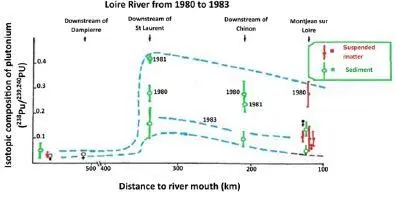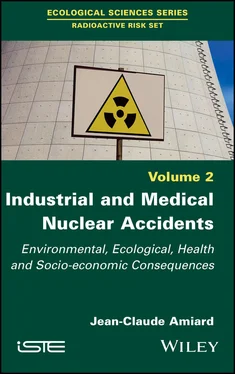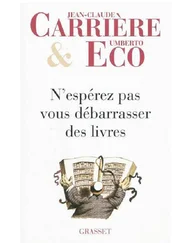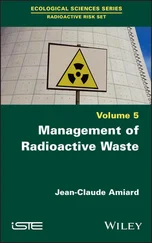Waste management incidents are few and far between. Among these, let us mention the explosion that occurred on Monday, September 12, 2011 at around 12 p.m. in the CENTRACO facility located in Marcoule, in the Gard, France (30). Operated by SOCODEI, this facility is dedicated to the processing and conditioning of low and very low level radioactive waste. The explosion occurred in the metallurgical furnace used to melt metal waste. One employee was killed and three others burned to varying degrees by a violent projection of molten metal in the facility’s hall. IRSN measurements confirmed the absence of radioactive releases to the environment off-site [IRS 12b].
There are also some risks associated with waste storage, such as leaks in tanks containing high-level liquid waste (e.g. Hanford mild steel tanks) [DET 74], which could lead to groundwater contamination. In the case of waste dumped at sea, contamination could result from a barrel crack (manufacturing defect) or corrosion, resulting in the release of radioactive materials. In France, at the Centre de Stockage des déchets à vie longue et haute activité de la Manche (CSM), stored tritium escaped into groundwater. Thus, between 1977 and 1992, tritium contamination reached values of 1.4.10 4–6.10 5Bq.L −1at different points from the slick to the center (ANDRA, 1992, in [GAZ 10]). In 2008, tritium concentrations in these waters reached values in the order of 10 3–10 5Bq.L −1at the site boundary (IRSN, 2008, in [GAZ 10]). In the waters of the St. Helena stream, tritium values were in the order of 5.10 4Bq.L −1in 1982, and concentrations reduced in 1992 to several hundred Bq.L −1[GAZ 10].
2.6. Incidents in the transport of radioactive packages
Prior to the 1970s, some accidents during the transport of radioactive materials by sea, air, rail and especially road led to local contamination of various aquatic environments [EIS 73].
In France, approximately 96% of radioactive substance packages are exclusively transported by road and the rest by a combination of several modes of transport (3% by road and air, 1% by road, sea and rail). Rail transport is mainly used by the nuclear industry. In 2014 and 2015, 139 and 122 events, respectively, were reported to the French Nuclear Safety Authority, corresponding to approximately one reported event for every 7,500 packages transported.
To date, in France, there is an average of one to two transport accidents per year, resulting in a release of radioactivity into the environment. These events have had limited consequences on human health and the environment, as most of them are ranked 1 on the INES. In the most serious cases in France, classified 3 on the INES, low levels of contamination were detected and could be treated by specific decontamination operations [IRS 16b]. The IRSN regularly identifies the various incidents affecting the transport of radioactive packages [IRS 11a, IRS13a, IRS13b]. Thus, the IRSN [IRS 16b] lists 16 significant transport incidents from 1983 to 2007, but with no consequences for the environment or health impacts.
Incidents of level 3 on the INES concerning parcels are few and far between. In France, only one case was noted in December 2001 when Federal Express transported an incoming package with a dose rate above the regulatory limit between Sweden and the United States via Roissy airport. This incident was classified by the Swedish Competent Authority as a level 3 incident. Similarly, in 2004, the dose rate measured in New Orleans (United States) on a package from Sweden containing sources of iridium 192 was too high.
Following a collision with the car ferry Olau Britannia 10 nautical miles from the Belgian coast, the cargo ship Mont-Louis sank in the North Sea 10.5 nautical miles north of the port of Ostend on Saturday, August 25, 1984 at around 7 p.m. This cargo carried 350 tons of uranium hexafluoride (UF6) in 30 48-Y containers. The uranium 235 content varied from 0.67% to 0.88% depending on the batch. In addition, two batches contained recycled uranium in varying proportions. The recovery of the 30 containers began on September 1 and ended on October 4, 1984. Only one small leakage was found on a single container, so the Mont-Louis maritime accident had no radiological or chemical consequences [AUG 85].
2.7. Environmental consequences
2.7.1. Uranium mines
Active uranium mines pose generally minimal environmental problems. On the other hand, abandoned mines often cause environmental damage. Waste rock from uranium ore that is too depleted to be economically viable still contains radionuclides from the uranium (or thorium) families which, if poorly controlled, can be leached and returned to the aquatic environment. The G@zette du Nucléaire dossier no. 111/112 deals with this subject [ANO 91].
In France, uranium ore exploration, production, processing and storage activities have been carried out at more than 200 sites in 27 departments. These activities have sometimes led to a change in the natural environment’s radiological state. This change may be significant from a measurement point of view without necessarily being significant from a health point of view. The IRSN [IRS 17b] has carried out several expert assessments of the impact of former French mining sites and proposes an environmental guide value for uranium equal to 0.3 μg.L −1[IRS 15b].
Approximately 160 TBq of noble gases and 2 TBq of gaseous iodine were reportedly released to the environment. Following the Tokai-Mura accident, the soils near the plant were contaminated with 24Na, 140La, 122Sb, 59Fe, 124Sb, 46Sc, 65Zn, 134Cs and 60Co [NAK 00].
2.7.3. Saint-Laurent-des-Eaux
The atmospheric emissions associated with the 1980 accident were estimated by EDF at 29.6 TBq in rare gases and 0.37 GBq in iodine and aerosols on the basis of the measurements made [IRS 15a].
Following the accident that occurred in March 1980 at one of the UNGG reactors in Saint-Laurent-des-Eaux, the fusion of two fuel elements from Unit 2 resulted in the release of a small quantity of plutoniums 239 and 240 into the Loire. This quantity was estimated at 10–20 mCi, or 535–740.10 6Bq, by Martin and Thomas ([MAR 88]). This represents between 0.063 and 0.322 g of 239,240Pu [GUI 16].
Thomas ([THO 82]) measured Pu activities in sediments and suspended solids (SS) from the Loire. The results show that the ratio of 238Pu/ 239.240Pu in particle matter is consistent with that of the overall deposition (about 0.05) upstream of the plants and in a single sandy sample taken downstream of the Dampierre plant, but this ratio reaches 0.15–0.42 downstream of St. Laurent. At the entrance to the estuary (Montjean), it is still 0.05–0.28 (Figure 2.4).
The IRSN [IRS 15a] states that the traces of the 1980 releases have no longer been perceptible in the Loire since 1994 and specifies that “the traces of plutonium measured in the soil as part of the monitoring near EDF’s nuclear sites are the result of the fallout from nuclear tests, with no discernible influence from releases from nuclear power plants”.

Figure 2.4. Isotopic composition of plutonium in sediments (full circles) and suspended solids (empty circles) in the Loire River between 1980 and 1983 [THO 82]. For a color version of the figure, see www.iste.co.uk/amiard/industrial.zip
Despite the partial melting of the reactor core and the significant release of radioactivity into the containment, the immediate radiological consequences to the environment were minimal. The containment has indeed fulfilled its role. The low releases to the environment were caused by the continued operation of a primary circuit effluent pumping system. Due to leaky circuits, hot contaminated water escaped into the building and vaporized, releasing the iodine and xenon it contained. These gases and vapors were sucked into the general ventilation of the building, through insufficiently efficient iodine filters, and released into the environment [IRS 12c].
Читать дальше













